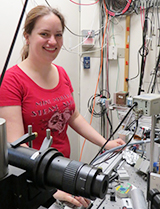X-RAY RUNS: Apply for Beamtime
2017 Nov 1 - Dec 21
2018 Feb 7 - Apr 3
2018 Proposal/BTR deadline: 12/1/17
2018 Apr 11 - Jun 4
2018 Proposal/BTR deadline: 2/1/18

Katharine (Katie) Silberstein is in her final year as a graduate student in the Abruña Electrochemistry Lab here at Cornell University. The Abruña group has over 20 years of experience in the in-situ and operando investigation of electrochemical interfaces using synchrotron radiation and Katie has spent countless hours here at the beamlines during her graduate studies.
What kind of research do you do?
My graduate research focused on the charge storage mechanisms of new lithium-ion battery electrode materials. If we have a better understanding of how molecules and nanostructures store charge, we can use that understanding to guide the design of materials and systems with better performance.
What led you to CHESS?
When I came to Cornell, I barely knew what a synchrotron was. All I knew was that it could generate x-rays which could be used in cool experiments. At first, I observed how other Abruña lab members used x-ray methods to gain structural and chemical information about energy storage materials. I saw that a great deal of mechanistic insight could be gained from these studies, so I wanted to do them too!
I took what I learned, and before long I was running my own weeklong experiments where I collected x-ray data from the active material of batteries as a function of state of charge. I kept coming back for more beamtime because I wanted to learn more! Every dataset I collected gave me deeper insight to the problems I was trying to solve, and sometimes they raised more questions.
Along the way there are several small victories in each beamtime, like when the sample is aligned just right or a motor stops misbehaving. You have to celebrate the little things! Often, my Eureka moments came during data analysis, like when I determined the expanded unit cell of a lithiated metal oxide.
Can you give us a little insight into your CHESS experience?
The most important skill I learned through my work at CHESS was how to keep calm under pressure. With a short amount of time to collect all of the data that you'll be analyzing until the next beamtime, you need to work efficiently and to be flexible and creative when challenges arise. I think CHESS is the perfect environment to do graduate work because you are always learning. All of the CHESS operators, scientists, and staff members want you to succeed and they do everything they can to make it happen, but when it comes down to it, it's really up to you. You must prepare for beamtime both as a scientist and as a human (i.e. bring snacks!). Sometimes a run won't go well, but you will still learn a lot, even if it is what not to do next time. By working "in the trenches", as Professor Abruña says, you very quickly become an independent researcher.
My graduate work at CHESS has prepared me well for my future work, and I can't wait to see what comes next!
Update: Where will you go next?
I will be doing a joint Postdoctoral Associate between CHESS and Professor Kyle Lancaster. While at CHESS I will be working with Ken Finkelstein, Staff Scientist, and will help design and commission x-ray Raman capabilities at Station C1. And while I am with Professor Lancaster, I will synthesize inorganic and organometallic compounds, calculate their predicted spectra, and collect x-ray Raman data.
Submitted by: Kathy Dedrick, CHESS, Cornell University
08/14/2015
